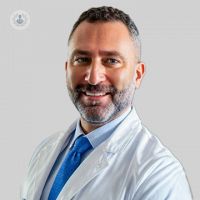Lower urinary tract symptoms (LUTS): What are the causes, symptoms and treaments?
Escrito por:In his latest article, highly-respected consultant urological surgeon Mr Giangiacomo Ollandini explains LUTS (lower urinary tract symptoms) in detail. He explains the symptoms, causes and treatments of LUTS.
What are the symptoms of LUTS?
LUTS (lower urinary tract symptoms) is an umbrella definition that relates to all the symptoms belonging to the lower portion of the urinary system. The urinary system starts with the kidneys, which filter blood and generate urine. This is drained by two tubes that connect the kidneys to the bladder and are called ureters. Both ureters normally end in the bladder, which is a reservoir of urine, terminating with the final part of the system, a waterpipe called “urethra” that allows delivery of the urine outside. The part of the urinary system made up of the bladder and urethra composes the lower urinary tract.
Symptoms related to this portion of the system include storage and voiding symptoms
Storage symptoms are those affecting the ability to effectively store urine, and can include urgency, frequency, incomplete bladder emptying, and nocturia.
Voiding symptoms are the ones that affect a normal stream of urine, such as slow flow, intermittency, and dribbling, but also an explosive urinary flow.
In addition, it is important to mention incontinence (leakage of urine) and pain or burning during urination.

What can cause LUTS?
LUTS are frequently associated with every condition that affects the lower urinary tract, and are certainly present during UTIs. Especially in men, however, they may be caused by progressive and unpredictable growth of the prostate, a gland situated just underneath the bladder. This gland has the function of producing most of the seminal fluid (with the exception of the spermatozoa) and typically tends to grow in men starting from 50 years of age or even less. Due to its position (the urethra is literally “hugged” by the prostate) a prostatic growth may obstruct the waterpipe and can cause a large amount of the above symptoms.
It is important to recognise an altered urinary pattern as soon as possible, because delaying the diagnosis of prostatic obstruction may lead to more serious consequences, for example, renal failure in the long run.
How is LUTS treated?
Depending on the cause of the symptoms, an appropriate treatment will be considered. Whilst UTIs are normally easily treated with antibiotics, prostatic obstruction may require some further investigations to be fully understood, and one or more medicines to be treated. The most typical classes of medications that are used are Alpha-Blockers, 5 Alpha Reductase Inhibitors and Anticholinergic drugs. At times, however, the medical treatment is not sufficient and more invasive options are needed.
Can LUTS be caused by stress?
Although the urinary system has a strong link with emotions, it is highly unlikely that stress alone can cause LUTS. A state of emotional distress may surely maximise the perception of LUTS. It is important to highlight what “stress” means in the urological world: in fact, the term “stress incontinence” (opposite to “urge incontinence”) does not mean a leakage of urine caused by emotional distress, but it is instead a very precise diagnosis of leakage of urine caused by the incontinence of the system in dealing with increased abdominal pressure. This can include the leakage of urine during coughing or when standing up from a sitting position).
Can LUTS be treated with surgery?
If medical treatment fails to treat LUTS caused by a prostatic obstruction, several procedures and technologies are available nowadays, with the aim of widening the waterpipe and therefore allowing a better stream.

What does the surgery entail?
Some of these techniques use technology to remove (TURP), vaporise (Greenlight Laser PVP), or literally steam-cook (Rezum) part of the prostate protruding into the water pipe. One of the most modern techniques (aquablation) uses high-pressure water jets with a robotic-assisted arm to obtain the same results. There are other options, like UroLift, where the prostate is left intact, but a special type of staples are positioned within it to allow an easier urine flow.
Mr Giangiacomo Ollandini is a revered consultant urological surgeon with more than 10 years of experience. If you would like to book a consultation with Mr Ollandini you can do so today via his Top Doctors profile.


